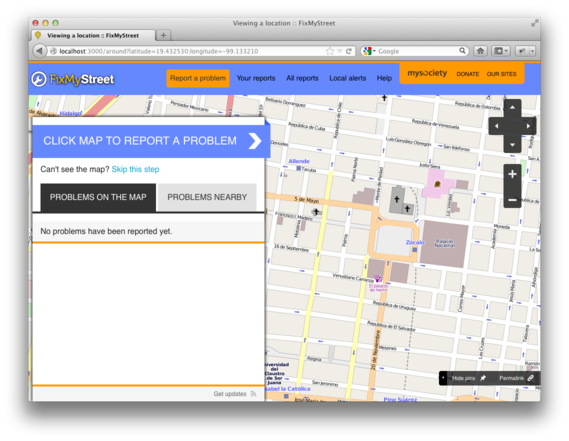Blog
-
Easy Installation 2 October 2012
Four months ago, someone raised a ticket on FixMyStreet’s GitHub account, asking for alternative ways of setting up an installation. We certainly agreed this was a good idea, as we’re well aware that there are various different parts to FixMyStreet that might require quite a bit of knowledge in setting up.
We’re now pleased to announce that we have created an AMI (Amazon Machine Image) containing an already set-up default installation of FixMyStreet. You can use this to create a running server on an Amazon EC2 instance. If you haven’t used Amazon Web Services before, then you can get a Micro instance free for a year.
If you have your own server, then we have separately released the install script that is used to create the AMI, which can be run on any clean Debian or Ubuntu server to set everything up for you, from the PostgreSQL database to nginx.
If you prefer to do things manually, and already know how to set up your database and web server, our manual documentation is still available.
An AMI and install script is also available for MapIt – see our MapIt documentation for more details. This should make it very straightforward to get something set up for testing and development.
Do let us know how you get on.
-
Improving Configuration 17 August 2012
Now that a default install is a bit more straightforward to set up, our thoughts turn to improving the customistation of that default install. Currently, apart from the options already present in the main configuration file, that involves knowing a bit of Perl, in order to create a Cobrand .pm file containing the various customistations. So to reduce that dependency, we’ve moved a number of these options into the main configuration file, so that hopefully a standard customisation might not need a Cobrand .pm file at all.
These changes range from simple text strings that are now in templates, through to specifying what areas from MapIt you are interested in, or what languages the site is available in. The general.yml-example file contains information on each option, and we’ve updated our customisation documentation as well.
Also, thanks to some testing of a current installation by Anders for FiksGataMi, we’ve made more incremental improvements to the installation, including fixing a couple of tests that shouldn’t run unless your configuration is set up in a particular way, making sure inherited cobrands use the best templates, and including the Catalyst::Devel module so running the development server is easier.
-
Default Workings 27 July 2012
In the past few weeks, a number of improvements have been made to the FixMyStreet default set up, so that installation should provide you with a working setup more easily and quickly, before you get on and make all the necessary customisations you will want to for the service you are setting up.
Firstly, we’ve tidied and consolidated the documentation on to this site, putting everything you need in one place. We are using GitHub pages, which means that the documentation is bundled along with the repository when checking out, which might be useful. The installation guide now includes help for installing on Mac OS X, and various other tweaks and improvements.
Next, the codebase now automatically defaults to OpenStreetMap maps and geocoding – these are available, with more or less data, everywhere in the world, so you should be able to test your installation and see working maps.
Whilst an installation of MapIt may be necessary for your FixMyStreet to work as you want – mapping locations picked to the right authority might need some private boundary data, for example – the code will now default to work as if everywhere is one administrative area.
The code for sending reports has been refactored and modularised, enabling proprietary options to be more easily added alongside the standard email, Open311, and so on.
We have removed any UK specific code from the default cobrand, moving it to a UK cobrand (which is then in turn inherited by the various council cobrands we have made in the UK). This should mean that you find you have less to override, and more things should work by default.

Lastly, the default cobrand now uses the new style that you can see on https://www.fixmystreet.com. By default, we have picked a pretty yet garish colour scheme, in order to remind you that you almost certainly want to change the colours being used for your own installation :)
-
An Introduction 6 February 2012
mySociety wrote FixMyStreet in 2007 in order to make it easy for people in the UK to report problems in their area. Since then over 200,000 problems have been reported to UK councils using the site. As with all our sites we want people everywhere to be able to benefit so we were delighted to work with the Norwegian Unix User’s Group (NUUG) last year to set up a FixMyStreet in Norway.
We want to build on that and help more people around the world install their own copy of FixMyStreet. In the months since FiksGataMi was launched we’ve made a number of changes to FixMyStreet to make it easier to install and customise for other countries. We’ve rewritten much of the code to use the Catalyst web framework which has helped make it easier to customise and we’re now improving the documentation and ironing out the installation procedure.
However, we know that easy to install code is only part of the process. Building a community around the software is far more valuable in encouraging people to use and improve it. This site and the new mailing list are our first steps along that road.
So, if you’ve ever wanted to have a FixMyStreet for your town, state or country then join the mailing list and we’ll help you along the way.